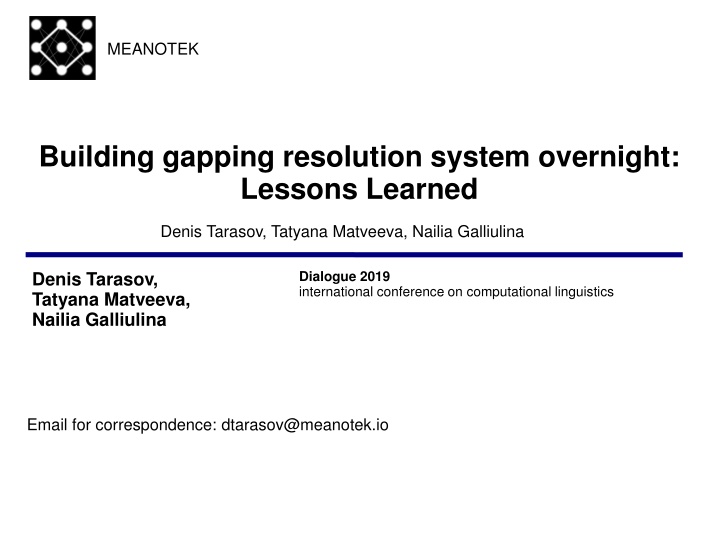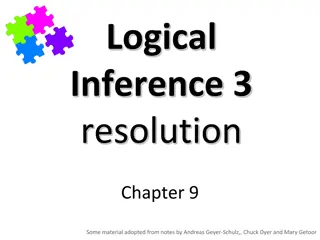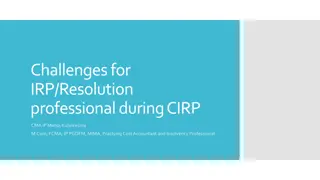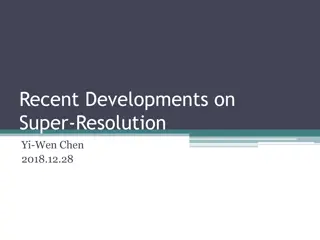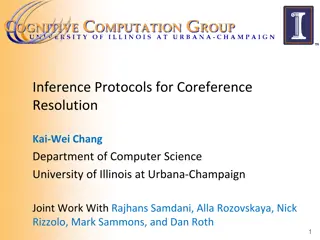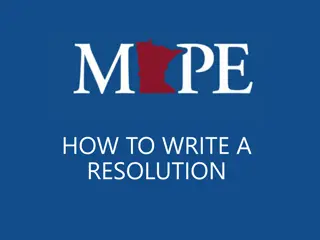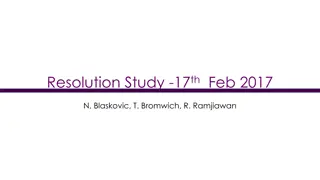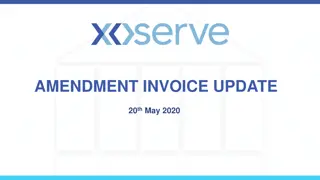MEANOTEK Building Gapping Resolution System Overnight
Explore the journey of Denis Tarasov, Tatyana Matveeva, and Nailia Galliulina in developing a system for gapping resolution in computational linguistics. The goal is to test a rapid NLP model prototyping system for a novel task, driven by the motivation to efficiently build NLP models for various problems. Utilizing character-level embeddings and LSTM language models, they address challenges such as maintainability and understanding in model improvement.
Uploaded on Nov 16, 2024 | 1 Views
Download Presentation

Please find below an Image/Link to download the presentation.
The content on the website is provided AS IS for your information and personal use only. It may not be sold, licensed, or shared on other websites without obtaining consent from the author.If you encounter any issues during the download, it is possible that the publisher has removed the file from their server.
You are allowed to download the files provided on this website for personal or commercial use, subject to the condition that they are used lawfully. All files are the property of their respective owners.
The content on the website is provided AS IS for your information and personal use only. It may not be sold, licensed, or shared on other websites without obtaining consent from the author.
E N D
Presentation Transcript
MEANOTEK Building gapping resolution system overnight: Lessons Learned Denis Tarasov, Tatyana Matveeva, Nailia Galliulina Denis Tarasov, Tatyana Matveeva, Nailia Galliulina Dialogue 2019 international conference on computational linguistics Email for correspondence: dtarasov@meanotek.io
THE GOAL Test of NLP rapid model prototyping system on novel type of the task
MOTIVATION The need to quickly and reliably build NLP models in large quantities for different types of problems The need for techology to be extensible and improvable
FIRST REQUIREMENT The need to quickly and reliably build NLP models in large quantities for different types of problems
SECOND REQUIREMENT The usual way to quickly obtain competive result is to find out current SOTA model, get its code from github, adapt it, if necessary or just train on new data
SECOND REQUIREMENT PROBLEM #1: This leads to unmaintainable software code when combined into complex pipelines
SECOND REQUIREMENT PROBLEM NUMBER 2: We cannot improve things that we do not really understand We don t really understand things that we can t duplicate ourselves Copying someone s else research puts us in position of forever catching up party
METHODS Character level context sensetive embeddeings based on language model Model parameters: 3192*2048*2048 LSTM language model trained on 2.2 GB of text (cleaned common crawl+books dataset) with the goal of predicting next character. Long BPTT length 350 characters
SIMPLIFICATIONS Task is considered to be sequence labeling task Position of V is start of R2 Gapping is present if R2 is present
MODEL OVERVIEW Softmax LSTM 256 LSTM 256 The cat sits on mat LSTM 2048 Pre-trained Part (fixed) LSTM 2048 LSTM 3192 Character embeddings, size 50
NeuThink Library Model definition using expression trees syntax Automatic generation of inference and training code Automatic guessing of suitable hyperparameters
DISCUSSION Need to extend system desing with new format converstion tools, to assist conversion from/to various data format types, since this seems to be main failure mode now Interesting that character-level models can form representations that are useful for representing long-distance relations Overall, results are sensible, given the time constraint
NOTES ON COMPETITIONS ORGANIZATION Automatic scoring during competition would be nice to have Standartization of formats and eval scripts Clear and consistent policy on after-deadline submissions
APPENDIX 1. How NeuThink differential programming model works
